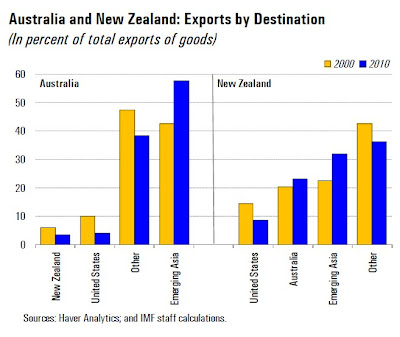The IMF has just released its new Regional Economic Outlook: Asia and Pacific: Managing the Next Phase of Growth, April <http://www.imf.org/external/pubs/ft/reo/2011/APD/eng/areo0411.htm>. There is an interesting little section on "Spillovers from Emerging Asia to Australia and New Zealand" on p.6.
The IMF notes that Australia is now much more dependent on "Emerging Asia's" (that's a category that includes China, Hong Kong SAR, India, Indonesia, Korea, Malaysia, the Philippines, Singapore, Taiwan Province of China, Thailand, and Vietnam) demand than it ever has been before. While this has been beneficial for Australia in recent years as Asia recovered quickly for the GFC and global recession, it also means that a slowdown in Asia will be felt brutally in Australia. As the IMF points out Australia’s exports to Asia have increased from 40 per cent of the total to 60 per cent between 2000 and 2010. Using a structural vector autoregressive (VAR) approach, the IMF concludes that over the past 10 years economic shocks from Asia are now considerably more important to the Australian business cycle than shocks from the United States.
For the sample period 1991–2010, a 1 percent shock to U.S. GDP is found to move Australian growth by about 0.4 percent. In contrast, GDP shocks from emerging Asia have an almost negligible impact on Australian growth. This result changes dramatically when limiting the sample period to 2000–10, for which a 1 percent shock to emerging Asia’s growth is found to shift Australian growth by ⅓ percent, whereas the impact of U.S. GDP shocks on Australia is no longer statistically significant.
Commodity prices dominate the transmission of shocks from emerging Asia to Australia. The three transmission channels identified in the model—trade, commodity prices, and financial variables (including interest rates and equity prices)—account for most of the estimated spillovers to Australia. In particular, commodity prices alone explain half of the spillovers from emerging Asia to Australia.
This means that Australia that there has been a switch in business cycle dependence - Australia has "decoupled" from US growth over the past 10 years and "coupled up" with Asia over the same period.
Note however that the jury is still out about whether Asia has decoupled from the United States over the longer-term. (Although it certainly appears that the decouplers are currently on top). The rest of Asia of course is increasingly tied into China's fortunes, making debates about China's inflation, housing bubble and debt increasingly important.
The IMF, like most Australian economic bureaucrats is bullish about Australia's economic future:
The long-term trend of continued strong growth in emerging Asia bodes well for Australia. The IMF’s Global Economy Model (GEM) can be used to assess emerging Asia’s impact on Australian long-term growth prospects. The model captures two main channels through which emerging Asia’s growth can affect Australia: trade integration and terms-of-trade gains. The simulation suggests that, should emerging Asia continue to grow notably faster than the world average, the impact on Australia will be even larger than in the past. This larger impact reflects both the increase in emerging Asia’s economic size and Australia’s growing integration with emerging Asia. Over the next 10 years, the model suggests that a 50 percent increase in emerging Asia’s real GDP, driven by tradable sector productivity growth, would raise Australian GDP by about 20 percent (figure). However, should emerging Asia’s economic growth become more balanced, with productivity growth in both tradable and nontradable sectors contributing equally, the growth dividend is roughly cut in half, owing to more modest improvements in the terms of trade of Australia.
A few other graphs also make interesting viewing about Australia's position in Asia. The first shows that Australia has relatively high real (after inflation) interest rates compared to a selection of other Asian economies and the second shows the significant real appreciation of the Australian dollar






No comments:
Post a Comment
Please be civil ...